Next Monday is Boxing Day in Canada. Monday also marks the opening faceoff of the 2016-17 WJC – also in Canada, incidentally enough, with the tournament being shared by Montreal and Toronto. After cutting Michigan defender and Blackhawks prospect Chad Krys on Christmas Eve, the American contingent is ready with their 23 players to try to improve upon their bronze medal finish from last year in Helsinki.
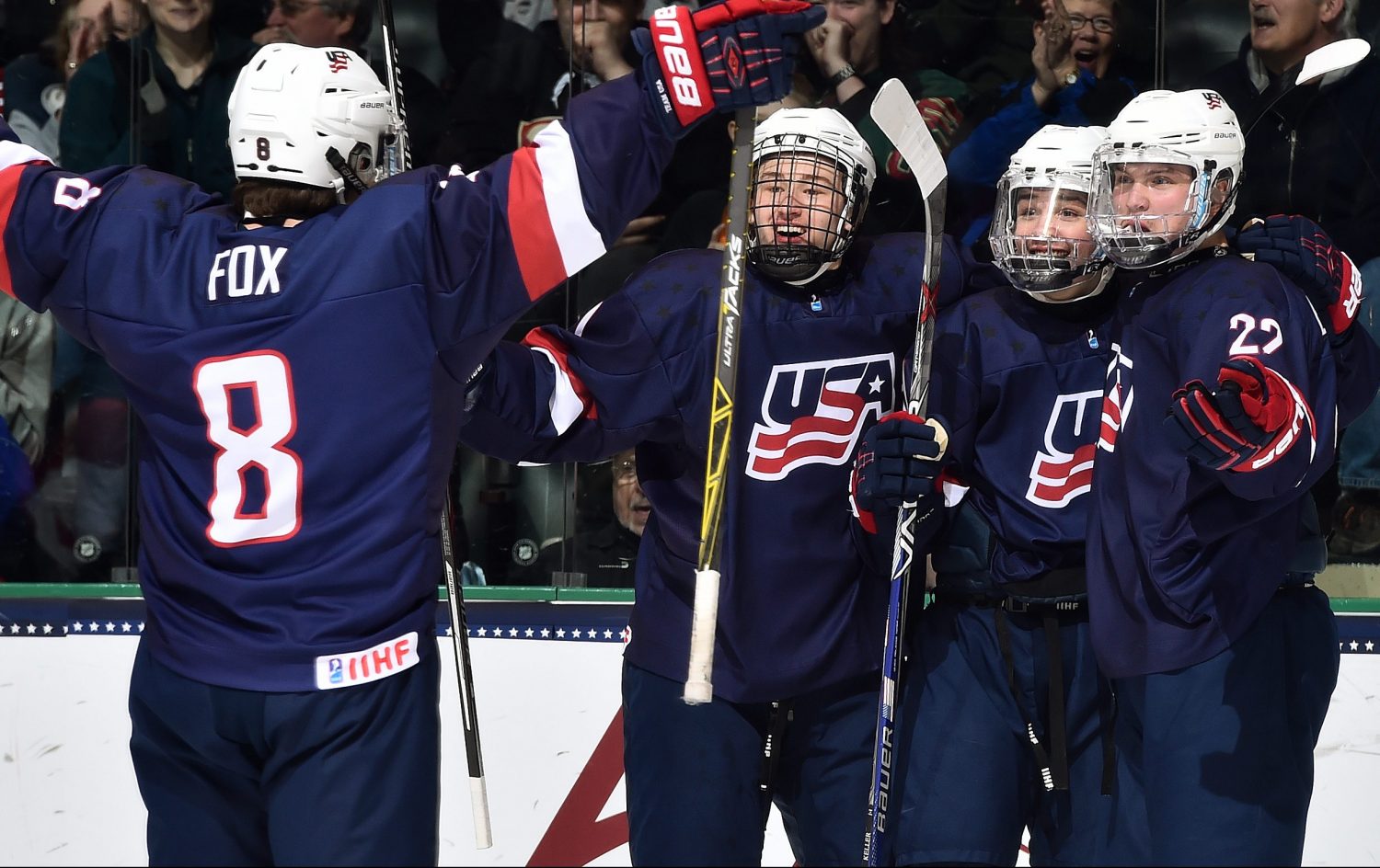
Goaltenders
Jake Oettinger (2017 draft eligible), G, Boston University (HE)
Tyler Parsons (Calgary, 2/54, 2016), G, London (OHL)
Joseph Woll (Toronto, 3/62, 2016), G, Boston College (HE)
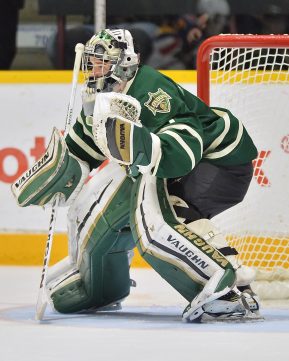
Although many pundits had unofficially tabbed Parsons as the likely starter for the American squad at the WJC, of the three netminders on the team, it was Joseph Woll who started the final pre-tournament tune-up game, and promptly shut out the Czech team. Parsons, who had played in the previous exhibition match, surrendered three goals to the Swiss. In fairness to Team USA head coach, Bob Motzko, all three options are good ones.
Woll, a graduate of the USNTDP program, has taken to the NCAA quickly, with a .917 save percentage and allowing 2.51 goals per 60 minutes. He blocks the bottom of the net well and fights hard for pucks. He has prototypical netminder size (6-4”, 205) and is fairly athletic to boot, with quick legs and sharp glove hand. He likes to leave his crease to cut down on the angles when the shooter is up the middle, but he will also sometimes drop into the butterfly too early and his footwork can get him into trouble, leaving him stranded in no-man’s land.
Oettinger, a teammate of Woll’s on last year’s USNTDP is a true freshman with Boston University and has been near unbeatable, with save percentage and GAA both in the top half dozen of all collegiate netminders. Like Woll, Oettinger is a butterfly netminder. Known for his calmness, positioning and mental preparation, he has already represented his country twice in the U-18 tournament and once more at the U-17 showcase. He is in the running to be the first goalie drafted this summer, but may be relegated to third string here, due to his age if nothing else.
Parsons was the second goaltender selected last year, only a few selections after Team Canada’s Carter Hart. One of three CHL players on the American roster, Parsons backstopped the London Knights to a Memorial Cup championship last spring. One of the more athletic goalies you are likely to see, the butterfly netminder is an exciting scrambler, willing and able to contort his body into a wide array of positions to make the save. His current season has been held back by injuries, but he has been solid for the Knights when healthy. This is his first time representing the Red, White, and Blue.
Defensemen
Jack Ahcan (2017 draft eligible), D, St. Cloud State (NCHC)
Joseph Cecconi (Dallas, 5/133, 2015), D, Michigan (Big 10)
Casey Fitzgerald (Buffalo, 3/86, 2016), D, Boston College (HE)
Adam Fox (Calgary, 3/66, 2016), D, Harvard (ECAC)
Caleb Jones (Edmonton, 4/117, 2015), D, Portland (WHL)
Ryan Lindgren (Boston, 2/49, 2016), D, Minnesota (Big 10)
Charlie McAvoy (Boston, 1/14, 2016), D, Boston University (HE)
One thing that sticks out when perusing the American blueline is their size, or rather, lack thereof. Only Cecconi is taller than 6-1”, and he and McAvoy are the only two weighing in at over 200 pounds. What they lack in size, they do make up with experience, as five of the seven are in their age 19 seasons.
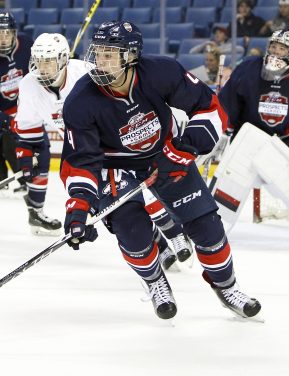
(Photo by Brian Watts / HHOF)
I expect McAvoy, the former Boston first rounder, to take on the biggest role. A good skater with a two-way game, he will likely begin to make his presence felt with a couple of crushing bodychecks. In his own zone, he can be tenacious and hard to shake. When he gets close enough to the puck carrier, he is as likely to use his stick to try to remove the puck as he is to take the body. He has a strong slap shot from the point and is a plus passer. This is McAvoy’s second go round at the WJC. He was solid last time, but failed to make the scoresheet. Wearing an ‘A’ this time, I expect him to figure into the offense more often.
Adam Fox and Ryan Lindgren were both part of last year’s USNTDP blueline and both are promising pro prospects, but while Lindgren has at times struggled to make his mark as a freshman with the Minnesota Golden Gophers, Fox has been lights out with Harvard. Undersized, Fox is a fantastic puck mover, with passes that are consistently crisp and on the button. He is a strong skater with very good acceleration, hitting top speed within only a few strides. He can also be dangerous on the man advantage, as he will step up into the circle if he spots an opening. From that reduced distance, his wrist shot can pick a spot. On a points per game basis, he is the leading defensive scorer in NCAA and I expect him to continue to produce offense from the back at the WJC.
Although I was a fan of Lindgren’s with the USNTDP last year, his first half season with the Golden Gophers has seen him struggle. Whereas he would always make the safe, simple play at the junior level, he was made a few too many unforced errors in college, something which has led to him spending an inordinate amount of time in the penalty box. As a member of the USNTDP squad, he would average around one penalty minute per game, so far, he has spent over three minutes per game in the box. Offense has also been harder to come by in the Big 10. Just like his play improved month over month in his draft year, he should continue to improve now although the US coaches should try to protect him from tougher shifts when possible.
I have to admit that after McAvoy and Fox, I find the American blueline crew to be a potential weak spot for them at this tournament. It is not so much that the other options are poor players, it is that none of them have standout skills. Fitzgerald is undersized and offensively inclined, but for every pretty pass, he will make one or two careless moves that lead to an inopportune giveaway. He should be used mostly in offensive situations. Cecconi brings the most beef to the game, but also the least offense. The Dallas prospect did not produce much offense for the Michigan Wolverines last year, when his teammates included Kyle Connor, Tyler Motte and JT Compher. Now that those three (and a few more besides) are gone, he is producing even less. He can skate well and is a solid penalty killer, but just as Fitzgerald should be used in mostly offensive zone shifts, Cecconi should take over when faceoffs occur in the US end.
Jones, whose brother Seth is a rising star in the NHL with Columbus, is a solid two-play defender, who has been A bright lights this season with the Portland Winterhawks of the WHL. A solid skater, he plays an aggressive game. His mix of skills should allow the Edmonton prospect to play whatever role needed by his team, including both special teams units, when physical play is needed, as well as with the more skilled forward lines.
Forwards
Joseph Anderson (New Jersey, 3/73, 2016), RW, Minnesota-Duluth (NCHC)
Kieffer Bellows (NY Islanders, 1/19, 2016), LW/C, Boston University (HE)
Jeremy Bracco (Toronto, 2/61, 2015), RW, Kitchener (OHL)
Erik Foley (Winnipeg, 3/78, 2015), LW, Providence (HE)
Jordan Greenway (Minnesota, 2/50, 2015), LW, Boston University (HE)
Patrick Harper (Nashville, 5/138, 2016), C, Boston University (HE)
Clayton Keller (Arizona, 1/7, 2016), C, Boston University (HE)
Luke Kunin (Minnesota, 1/15, 2016), C, Wisconsin (Big 10)
Tanner Laczynski (Philadelphia, 6/169, 2016), C, Ohio State (Big 10)
Jack Roslovic (Winnipeg, 1/25, 2015), C/RW, Manitoba (AHL)
Troy Terry (Anaheim, 5/148, 2015), C/RW, Denver (NCHC)
Tage Thompson (St. Louis, 1/26, 2016), C/RW, Connecticut (HE)
Colin White (Ottawa, 1/21, 2015), C/RW, Boston College (HE)
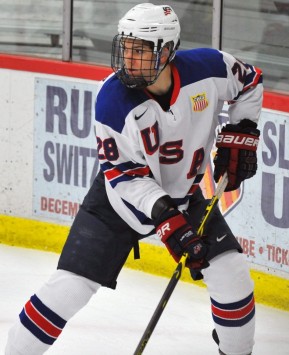
In recent weeks, I have written about both Roslovic and Laczynski, and I will repeat again that I really like both as prospects and both to play key roles for American hopes of a medal.
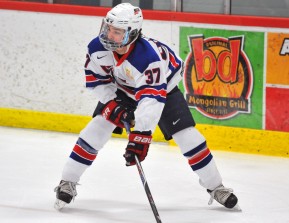
Last year’s USNTDP squad featured an electric first line of Clayton Keller between Kieffer Bellows and Joseph Anderson. Bob Motzko will have the opportunity to reunite the trio in the next few weeks. Although his freshman season has been limited by injuries, Keller is healthy now and is as hard to keep off the scoresheet as ever, with 15 points in his first 10 collegiate games. Undersized, the Coyotes prospect is more slippery and agile than fast. He also has more puck skills than anyone else on this roster. His commitment to detail off the puck can waver occasionally, but he is usually responsible and does what he can to help regain possession. And when he has the puck, magic happens. Last year, that magic often culminated in a hard shot on net from Bellows. Both Bellows and Keller are with Boston University and Bellows has brought his physical power forward game with him from the USHL.
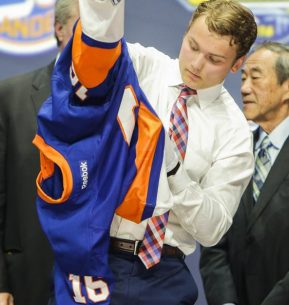
A shoot first player, he can skate and has solid puck skills, but his main drawback in juniors was lapses in hockey sense that led to unfortunate decisions and often a couple of minutes to think about it in the penalty box. If he is not reunited with Keller, Bellows should play a bottom six role. The mule on that line last year was Joseph Anderson, now with the UMD Bulldogs. Anderson has taken to the collegiate game better than former linemate Bellows, contributing around one point per game as a freshman. What Anderson lacks in foot speed, he makes up with plus hockey IQ. He has a knack for picking the right spot to get to and making the smart hockey play once he is there. He is a versatile player who could fill a number of roles for Team USA.
I have already discussed four players from Boston University. The Terriers actually sent two more to represent their country in giant winger Jordan Greenway and the minute Patrick Harper. I will admit to not being a big fan of Greenway. At 6-5”, 229, he brings more beef to the table than anyone else on this roster and in fact, there are very few in the tournament in his weight class. Unfortunately, I have never been impressed with his game. He can be effective on the cycle, with his size and decent puck protection skills, but most of his points are created by his linemates. Harper has scored wherever he has played in his life, up to and including his first half season of collegiate hockey. He will need to be protected in terms of his usage but he has a nose for the puck, is quick on his feet and has a surprisingly powerful shot for such a diminutive player. This tournament could be his coming out party for the greater hockey world.
If this team has a power play specialist, it is Huskie (but not husky) Tage Thompson. After scoring 13 of his 14 goals last year with the man advantage as a freshman, five of his 12 this season also have come a man up. Tall and lean, Thompson plays responsibly in both ends, but does his best work when the opposing net is in sight. He can pass but is more dangerous as a shooter. I have concerns about his foot speed, but early reports from his sophomore season indicate that he has improved his stride, and with it, his effectiveness.
In terms of both on-ice leadership and two way play, the Red, White, and Blue are relying on Colin White and Luke Kunin, the latter of whom was selected as captain of the squad. Both players are former first rounders who can do a bit of everything, highlighted by high end hockey IQ. They can both play center and on the wing, and are both plus skaters. White has great hands and finishing skills and has a long history of excelling as a penalty killer. He was one of the Americans’ better players at last year’s WJC with seven points. Kunin plays with a high rev motor. Now in his sophomore season with Wisconsin, he has never let the relative weakness of his collegiate team get in the way of him giving his all on the ice. He scored 19 goals last year as a true freshman and has 11 more in his first 16 games as a sophomore. He is an aggressive player and gets high marks in skating, shooting, puck skills, hockey sense and physicality. I expect big tournaments from both players.































